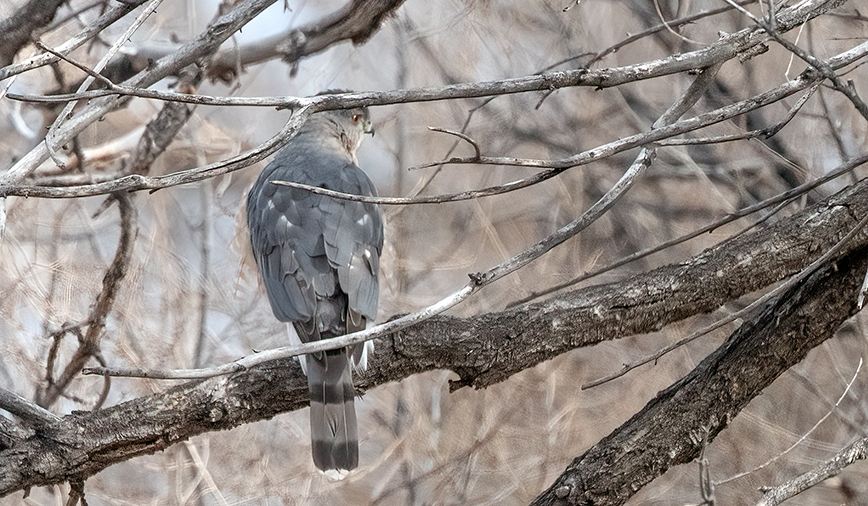November 29, 2013 Coopers Hawk
If you sat down to a turkey dinner this week, count yourself in the majority. According to a Turkey Quiz recently circulated by Kane County Audubon (thanks Bob Andrini!), 90% of American homes serve turkey on Thanksgiving Day. These folks, present company included, help account for the 45 million turkeys and 525 million pounds of turkey meat estimated to be consumed over this long holiday weekend.
While so many of us were downing plate after plate of delicious bird—not to mention stuffing, mashed potatoes, sweet potatoes and pumpkin pie—some of our wild neighbors were enjoying a birdie feast of their own.
Say hello to Accipiter cooperii, the Cooper’s hawk, a raptor renowned for its ability to eat birds, not just on Thanksgiving Day, but throughout the year.
Looking at the Cooper’s lean, streamlined build, you can tell this is a bird that’s serious about its life mission. Its long tail, which acts like a rudder, and relatively short wings give it the maneuverability it needs to chase down small-to medium-sized birds, which make up about 75% of its diet and might be prone to overpopulation were it not for A. cooperii.
Think of Cooper’s hawks as fighter jets, patrolling the skies in search of avian prey. Sharp-eyed and gifted with the ability to turn on a dime, they can make quick work of a mourning dove, robin or other bird species, often seizing the unsuspecting prey in midair.
By way of contrast, the red-tailed hawk, Buteo jamaicensis, our area’s other common diurnal raptor, is
adapted for swooping down to the ground to pounce upon mammalian prey like squirrels and chipmunks. Birds typically make up a mere 10% of the redtail’s diet.
You also can tell a Cooper’s from a redtail by their
habits in flight. Whereas redtails typically soar, with
only an occasional flap of the wings, the Cooper’s flight style can be described as flap-flap-glide, over and over again. The Coop’s long tail, which is boldly marked with thick, dark bands, is another prominent clue.
Sometimes a Cooper’s presence isn’t indicated by the animal itself, but rather by the signs it leaves behind. These birds pluck their prey first before consuming it, a behavior that produces conspicuous piles of feathers as evidence.
Many people come to know Cooper’s hawks through the popular hobby of birdfeeding. Although Cooper’s hawks don’t eat seeds, they will sometimes help themselves to a bird or two that has come to take advantage of a free buffet. (If you find that you’re being visited by Cooper’s hawks more often than you’d like, and you have birdfeeders outside, the easy fix is to bring the feeders in for a little while. The songbirds will be just fine without your generous gifts for a few days, and the Cooper’s will move on to
other hunting grounds.)
Listed as endangered in Illinois as recently as 20 years ago, Cooper’s hawk populations are considered stable these days. While birdfeeding may be contributing to this trend, bans on harmful pesticides also
has proven helpful, not only to Cooper’s hawks but also other birds of prey, including bald eagles.
Another possible reason for the Cooper’s current success might be the large numbers of starlings and rock doves—a.k.a. pigeons—that thrive in urban and suburban environments. These introduced species rank high on the list of Cooper’s preferred prey items, and are not hard to find even on days when there are no birdfeeders in sight.
But even with fewer pesticides to contend with, and an abundance of prey, the life of a Cooper’s hawk isn’t easy. A study that examined the skeletons of 300 Cooper’s hawks found that 69, or 23%, had furculae that had been fractured and then healed. (Furculae, by the way, is another name for wishbones.)
This weekend, if you head outside for a walk in between meals of turkey sandwiches, turkey casserole and turkey-noodle soup, keep your eyes open for Cooper’s hawks. Look up in the sky for birds displaying that tell-tale wingbeat pattern (remember, flap-flap-glide) and look down on the ground for small mounds of feathers and fluff. Think of them as all that remains of a great bird meal–the leftovers, so to
speak…
Pam Otto is the manager of nature programs and interpretive services at the Hickory Knolls Discovery Center, a facility of the St. Charles Park District. She can be reached at 630-513-4346 or potto@stcparks.org.

